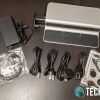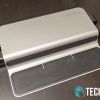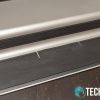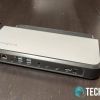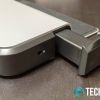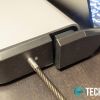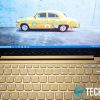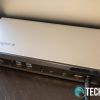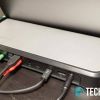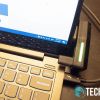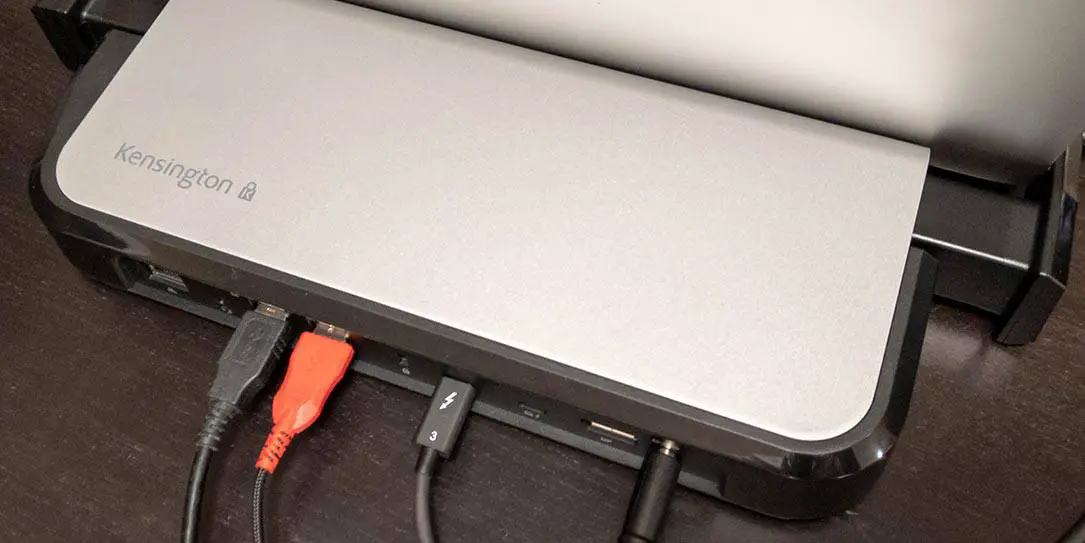 We’re pretty much at the stage of needing a USB Type-C dock with our ultrabook laptops. With ultrabooks getting thinner with each iteration, there is less space for ports and most designs are moving to one or two USB Type-C ports. Fortunately, there are USB-C and Thunderbolt 3 docks to give you extra ports. Our Kensington LD5400T review takes a look at one such dock which also secures your laptop with a K-Fob Smart Lock and included lock cable. Read on for our full review.
We’re pretty much at the stage of needing a USB Type-C dock with our ultrabook laptops. With ultrabooks getting thinner with each iteration, there is less space for ports and most designs are moving to one or two USB Type-C ports. Fortunately, there are USB-C and Thunderbolt 3 docks to give you extra ports. Our Kensington LD5400T review takes a look at one such dock which also secures your laptop with a K-Fob Smart Lock and included lock cable. Read on for our full review.
Specifications
The Kensington LD5400T Multi-User Thunderbolt 3 Dock with K-Fob Smart Lock has the following features and specifications:
- Connection Technology: Thunderbolt 3 (Cross-Platform Compatibility)
- Additional Screen Outputs: 2
Video Ports: DisplayPort, USB-C - Maximum Resolution: 4K
- Power Delivery: 85W
- Operating System(s): macOS, Windows
- Number of USB Ports: 5
- USB Fast Charging: No
- Docking Station Family: The Innovator
- DockWorks: Yes
- Best For: Thunderbolt 3 Laptops, Ultrabooks and Monitors that support up to 4K
- Compatibility: Windows 10, macOS 10.13 or above
- USB 3.0 Ports: 4 x USB 3.0 Ports (back) supporting 5V/0.9A
- Audio: 1 x 3.5mm Combo Microphone & Headphone Port (rear)
- Data Transfer Speeds: Supports up to 40Gbps data transfer speed
- Ethernet Speed (Mbps): 1000, 100, 10
- Maximum Resolution Supported
- Single Monitor: 5K (5120 x 2880 @ 60Hz)
- Dual Monitors: 4K (4096 x 2160 @ 60 Hz)
- Mounting Option: Optional – permanently secure using the desktop mounting holes
- Plug & Play: Plug & Play installation without the need for drivers or downloads
- Security Slot Compatibility: Product includes tethered security cable and optional built-in Kensington Security Slot
- System Requirements: Only compatible with laptops equipped with Thunderbolt 3 ports; not backwards compatible with Thunderbolt 1 or Thunderbolt 2. For Windows-based devices, ensure your laptop supports Power Delivery.
- USB-C Power Delivery: Supports USB-C PD 2.0 (85W of laptop charging)
- Video Output: Optional Secondary Monitor via USB-C video adapter, 1 x DisplayPort v1.2
- 4K Support: Yes
- Daisy Chaining: Daisy chains up to 5 additional Thunderbolt 3 devices
- Power Adapter Rating
- Input: 100-240V; 2.5A Max
- Output: 20V DC; 8.5A, center-pin positive polarity
- Unit Dimensions (WxDxH): Width: 320 x 220 x 44mm (12.6 x 8.7 x 1.7in)
- Unit Weight: 1.5kg (3.4lbs)
- Security Cable: 7×7 wire; 4mm core coated to 5mm; Length 1.8m (6.0ft)
- Thunderbolt 3 Cable: 0.5m (1.6ft)
- Warranty: 3 Years
What’s in the box
- Kensington LD5400T Multi-User Thunderbolt 3 Dock with K-Fob Smart Lock
- Two User Key Fobs on One Key Ring
- One 0.5M Thunderbolt 3 Intel Certified Passive Cable (40Gbps)
- One 0.5M USB 2.0 Male to USB 2.0 Male Cable
- One Security Cable
- Power adapters for multiple countries (NA, AU, UK, EU)
- One Quick Start Instruction Guide
- Warranty Information & Compliance Sheet
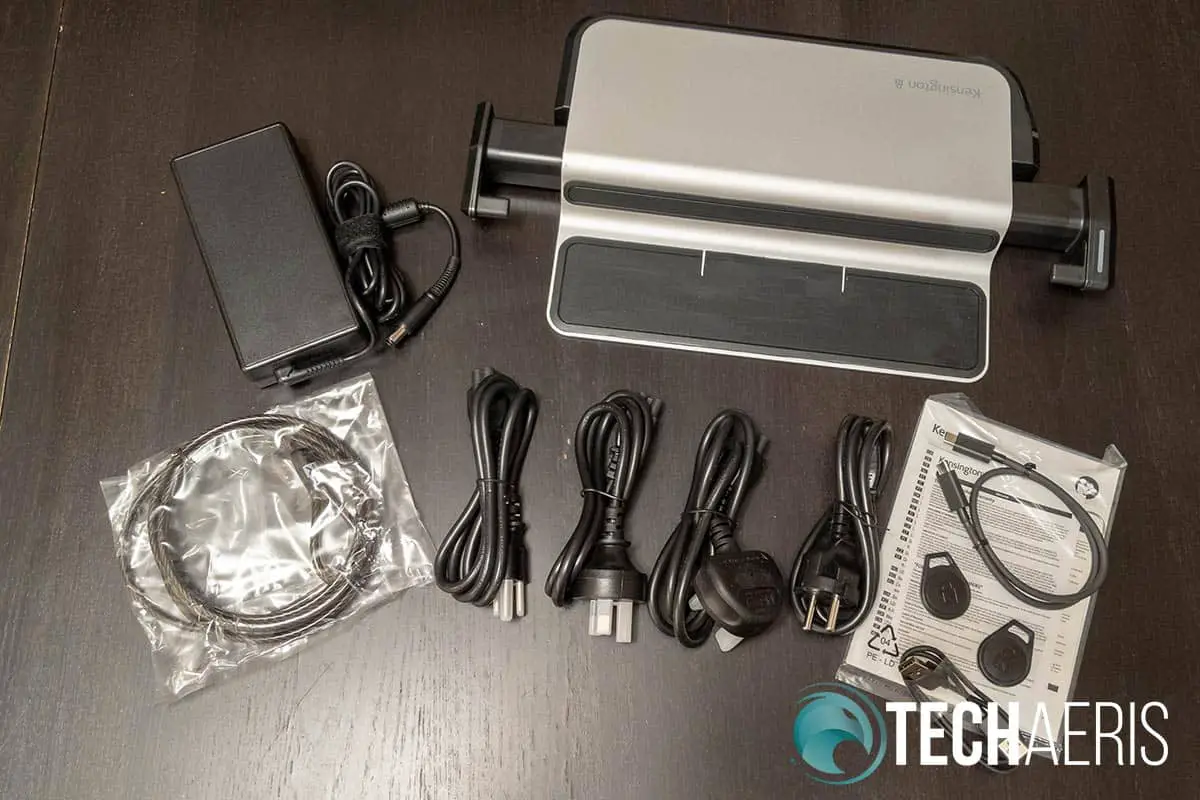
Design
As far as docking stations go, the Kensington LD5400T is fairly sleek with its solid construction. The main portion of the base is constructed of silver aluminum and is roughly twelve inches wide, five inches deep, and one-and-a-half inches in height. The Kensington logo is printed on the back lower left corner (when looking at the back).
The sides and back have a three-eighth of an inch black plastic moulded piece around it. Towards the front of the dock, you’ll find the adjustable security arms. Behind the left arm is a hole for the included security cable. The arms move in and out and click into place when the unit is powered and activated to lock in place. The arms adjust to accommodate laptops that are between 11 and 15-inches in width. The end of the arm is roughly three-quarters of an inch thick, three inches deep (angling up towards the front), and one-and-three-quarters of an inch in height. On the right arm is thin LED light about an inch long. This light changes colours based on the operation you are performing, which we’ll cover later. A rubberized nub on the front of this piece sits about an inch from the main arm and is just under three-quarters of an inch in length. This spacing should definitely accommodate the display thickness of most laptops available today.
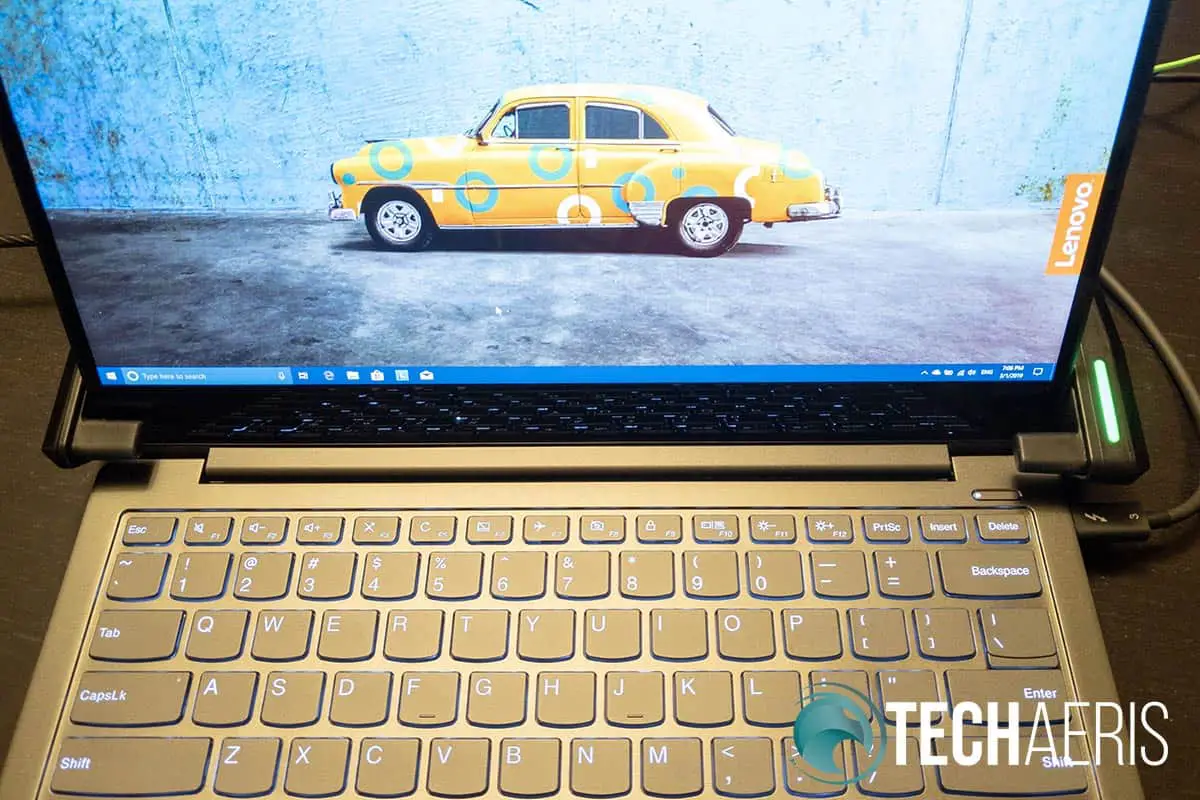
The main unit curves downwards and morphs into a plate, so to speak, which is eleven inches wide and just over three inches deep. A rubber mat is attached to this and is where your laptop rests on when used with the dock. If you lift up this rubber mat, there are two screw holes which can be used to screw the dock to a desk or workstation (screws not included). Along the back edge is another rubber bumper to prevent the lid of your laptop from scratching against the main dock unit.
Around the back of the dock is where all the additional ports are. From left to right (when looking at the back), you’ll find a Gigabit Ethernet port, 3.5mm audio port, four USB-A 3.0 ports, Kensington security slot, two Thunderbolt 3 USB Type-C ports, DisplayPort v1.2, and a DC20V adapter port.
The bottom of the dock is pretty simple and has four circular rubber pads in each corner and two slimmer ovalish shaped pads in the middle for added grip.
The dock isn’t light either, coming in at 1.5kg (3.4lbs) but it’s meant to be placed and used in one spot. The weight also means it won’t move around if it hasn’t been screwed into place, offering a solid base for your docked laptop.
The K-Fob key is a simple plastic disc with a loop to attach to a key ring. On one side is the Kensington lock icon while the other has a six digit number that you can use to register your K-Fob to use with other Multi-User LD5400T docks in shared workspace environments.
The included security cable is nice and thin, coming in at 5mm in diameter total. That being said, it definitely feels sturdy and you’d likely need a strong pair of bolt cutters to cut through it.
The included power adapter consists of your typical brick with the DC20V plug attached to it on one end. The other end has a three circle plug format which accommodates the included power cables. Rather than just including clippable ends for different outlets like some OEMs do, Kensington has included an actual cord for NA and separate ones for AU, UK, or EU outlets.
Ease of Use
The Kensington LD5400TMulti-User Thunderbolt 3 Dock with K-Fob Smart Lock is pretty straightforward to use. If you wish to attach it to a desk or workstation, you’ll need to purchase a couple of screws and then you can secure it to your workstation. Once secured, start by plugging it in using the correct adapter for your country. Next, loop the security cable around the leg of your desk or table, feed the end through the loop and push it into the hole on the left side of the dock. It will feel loose at first and won’t lock fully until the arms are pushed in past the lock indicator printed on them. Once in place though, the cable holds firm and can’t be removed until the arms are fully extended again.
Next, use one of the included K-Fob keys and hold it against the right arm. The light will turn green, indicating the unit is ready to lock. Place your laptop on the base and close the arms until you hear the last click before the arm touches the side of your screen. While you can push it tight against your screen, it won’t click in place and you may have issues unlocking it. Once in position, the green light will go out.
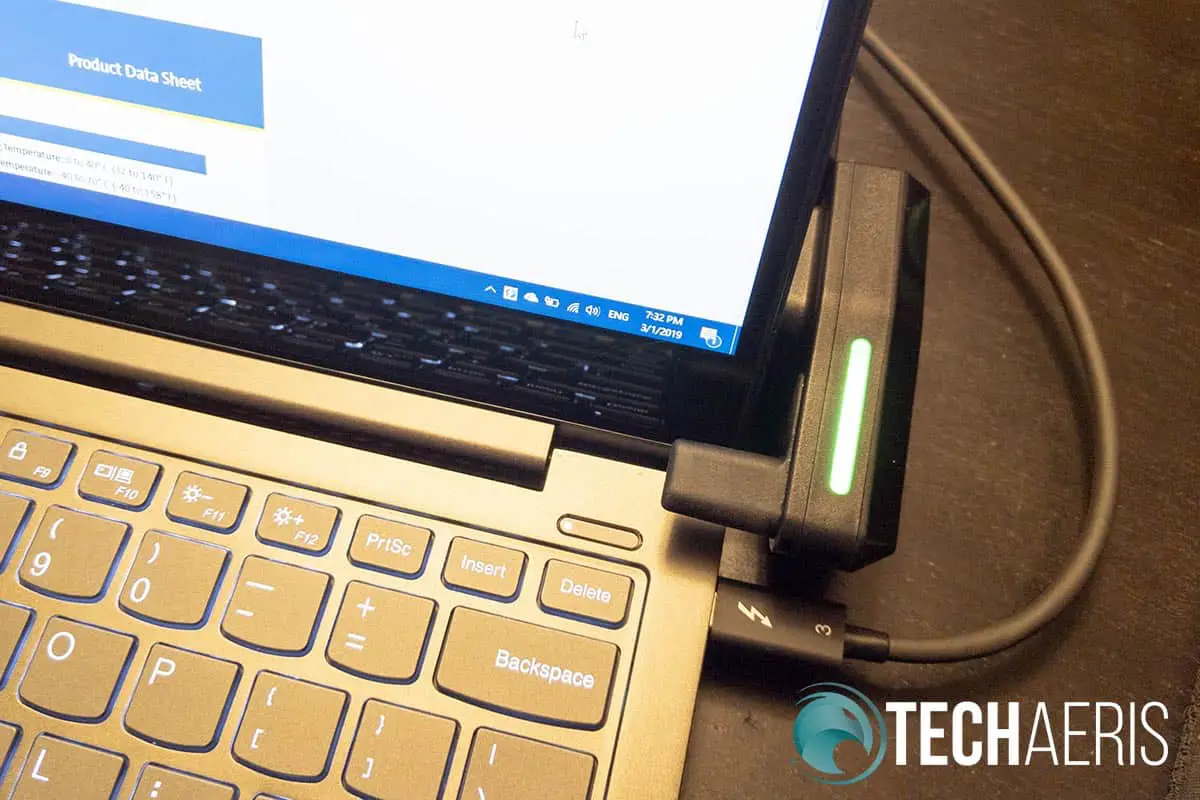
Once in place, connect the included USB Type-C Thunderbolt cable from the Thunderbolt port marked with the power bolt and computer to your laptops USB-C port that supports Power Delivery. While this should be the same one you plug into, on the Lenovo Ideapad 730S that we tested this with, we had to use one of the other two available USB-C ports to get full functionality. It should also be noted that even though this is a 170W dock, it only supports up to 85W of power delivery so if your laptop requires more than that, you won’t be able to use the dock to its full potential. We did test it briefly with a laptop requiring 130W of power and the computer complained about using a lower power source and the ports on the back wouldn’t function properly.
After you’re all hooked up, you can then plug in your peripherals like a mouse, USB hard drive, headset, or monitor via USB-C or DisplayPort and you’re off to the races. Additionally, you can get a USB-C to DisplayPort or USB-C to HDMI adapter to use with a monitor that doesn’t have USB-C ports for connectivity.
When you’re ready to go, simply unplug the USB-C cable connecting the laptop to the dock then place your K-Fob against the right arm. The LED should turn blue and the arms should open. If the LED turns red, it means you’re trying to open it with the wrong fob. But wait, this comes with the correct fobs, right? While that is correct, there are actually two models of the LD5400T. The one we tested is the Multi-User version while there is also a Single-User version model. The Multi-User version is perfect for shared workspaces and allows for users to register their K-Fob online. Any registered K-Fob can be used to use the Multi-User LD5400T. Whichever K-Fob is used to lock the dock must be used to unlock the dock. The Single-User LD5400T can only be locked or unlocked with the included K-Fob. As we only had the one set of K-Fobs, we couldn’t test trying to unlock it with a different K-Fob than it was locked with but we didn’t find any mentions of this happening when trying to Google the potential issue.
Software
From an end-user perspective, the Kensington LD5400T can be used out of the box with the included K-Fob keys. However, there is an optional Kensington DockWorks application (https://www.kensington.com/dockworks/) that you can download and run. As an end-user, the only real benefit is being able to enable Wi-Fi auto-switching so if the dock is connected via Ethernet, it will disable your Wi-Fi to prevent your laptop from using the (presumably) slower Wi-Fi versus the faster wired network.
The real benefit of DockWorks lies on the admin side. From the DockWorks website:
And for IT Admins, DockWorks monitors network and device connections, and even mirrors the laptop’s MAC ID to the docking station, helping to keep security threats low and network throughput high. Perfect for hot-desking environments.
IT administrators have master access to all stations, such as those used for shared, hot-desking, or hoteling workspaces.
On that note, we didn’t get a chance to test out the DockWorks software from an IT perspective as that requires requesting the software from Kensington through a form on the DockWorks website.
On that note, to be honest, I’d probably skip using the software from an end-user perspective as the Wi-Fi auto-switching is something you can really manage yourself if you’re so inclined or concerned about which network you are using and connected to.
Performance
As far as performance is concerned, once connected to the laptop, all the ports worked as expected. At its maximum, I had a 4K monitor connected via DisplayPort, a USB-C hard drive, two USB-A devices (a mouse and another external hard drive), an Ethernet cable, and a headset connected all at the same time. Input response was great as were the transfer speeds from the hard drives and over the wired network. In addition, it handled the 4K display just fine. While we didn’t test it out, the nice thing about this dock is that it supports dual 4K monitors if that’s what you have for your setup.
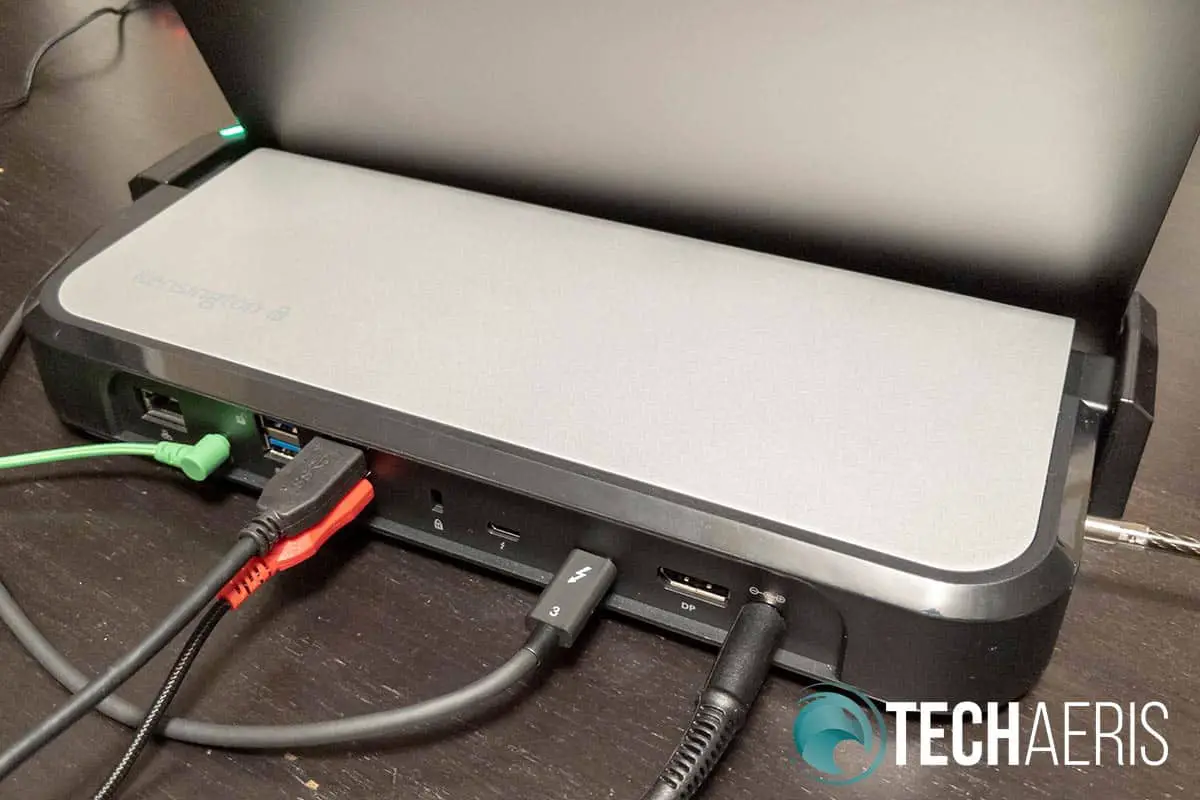
While the dock works best plugged into the wall and then the laptop plugged into the dock, you can power the dock off the laptop with the included USB-A cable. This is only meant in the event that the power goes out and you need to unlock the dock to remove your laptop. During our testing, this process worked as intended and is a great backup forsight in case of a power outage.
Protection
On the protection side of things, the Kensington LD5400T definitely secures your laptop in place once it’s locked. For multi-use and shared areas, being able to screw it in place is a definite bonus. While it also comes with a security cable, the unfortunate thing is that a user could theoretically remove the cable once the dock arms are fully extended. However, that makes it great if it is your dock and you want to secure it while at the coffee shop (I’m sure you’d get some looks) or elsewhere. If you’re using this in a shared workspace environment, chances are it would be both screwed in place and further secured with the Kensington lock slot on the back.
As well, although we were unable to try different K-Fob keys, given Kensington’s track record with docks and security coupled with our inability to find any posts stating otherwise online, we’re confident your laptop will stay locked and secured until you unlock it with the K-Fob that you locked it with.
Price/Value
Interestingly enough, both the Multi-User and Single-User versions of the Kensington LD5400T Thunderbolt 3 dock with K-Fob Smart Lock both retail for US$449.99. Considering non-locking Thunderbolt 3 docks run for much less, you are paying a premium for the extra locking features. While the price seems steep, the price of protecting your investment may be worth the cost, especially in a shared use environment. Alternatively, it great add-on to offer as a service if you’re a hotel owner for your business guests.
Wrap-up
The Kensington LD5400T Multi-User Thunderbolt 3 Dock with K-Fob Smart Lock does a great job of securing your laptop while at the same time providing you with extra ports not normally found on newer laptops.
*We were sent a sample of the Kensington LD5400T Multi-User Thunderbolt 3 Dock with K-Fob Smart Lock for the purposes of this review.
Last Updated on February 3, 2021.

